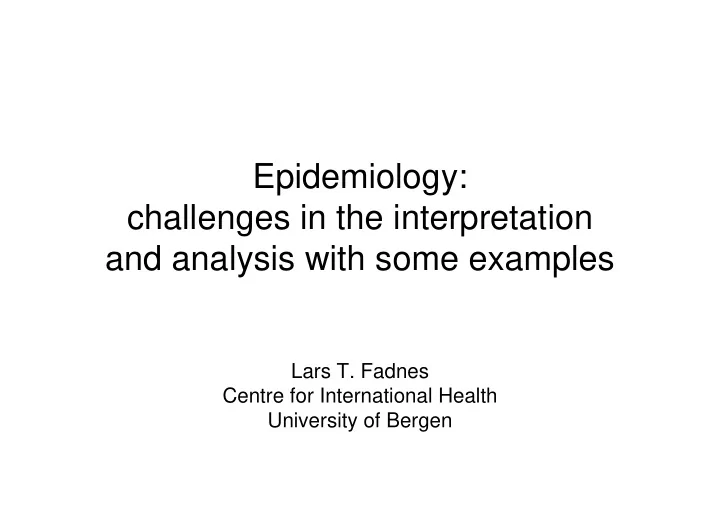

Epidemiology: challenges in the interpretation and analysis with some examples Lars T. Fadnes Centre for International Health University of Bergen
Example • Zinc sirup – Metallic and bitter taste – Accepted mostly by the most sick and less by the healthier • Placebo sirup – Taste like fruit juice – Accepted my most children
What are the challenges? Per protocol Epidemiology: challenges in the interpretation and analysis with s Taking all doses Proportion Randomised to taking all doses treatmentarm in analysis zinc Most sick 55 45 82% Least sick 110 55 50% placebo Most sick 55 50 91% Least sick 110 100 91% Intention-to-treat analysis
Interactions/ effect modification • The effect of one factor on the outcome is dependant on an other factor • How to assess? – Stratified analysis – Multivariable analysis • E.g. effect of treatment (zinc) on diarrhoea severity is depending on whether the child had fever or not – Those with fever had protective effect of zinc – Those without fever had no positive effects of zinc
• Observation of associations between investigated exposure factors and their outcomes does not necessarily imply causation. In the absence of random error and bias, there are three possible explanations for these associations in nature: 1) The exposure causes the outcome 2) The outcome causes the exposure (reverse causation) 3) The exposure and outcome share a common cause
unlikely if the exposure always comes before the outcome
What is this effect called? Confounding…
Confounding • Exposure and outcome share a common cause – Confounding can be seen as a mixing of effects – A confounder is a variable that causes confounding or a variable which removes confounding when adjusted for – hinders our ability to see the true causal effect of the exposure on the outcome • When do we need to suspect it? – Imbalance in factor/ determinant between the exposed and unexposed groups • Design – Randomisation (equal distribution of common causes of both the exposures and outcome) – matching of cases • How to assess? – Stratified analysis – Multivariable analysis • regression methods to control for multiple confounders at the same time
Mediation
Accuracy versus precision High precision, but low accuracy High accuracy, but low precision
Before you finish… • Take 1 minute to fill in short evaluation of these sessions in the computer lab on the following web site http://evaluation.fadnes.net/
Questions and comments
Installation of RcmdrPlugin.Cih.Epi • Install R (if not done already) – http://www.r-project.org/ • Install package Rcmdr (if not done already) Package Install package scroll down to Rcmdr click OK – • Install package Epi Package Install package scroll down to Rcmdr click OK – • Download RcmdrPlugin.Cih.Epi from http://statistics.fadnes.net/epi/ • Install package(s) from local zip file (choose the package you just downloaded) • Open program – Load package Rcmdr Tools -> load Rcmdr plug-in(s) RcmdrPlugin.Cih.Epi – • click ok and Yes • Now you are ready
Recommend
More recommend